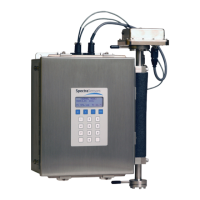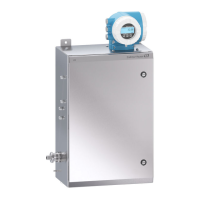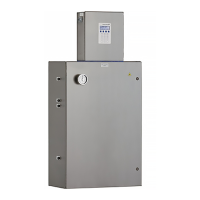SS500/SS2000 Analyzer
3–4 4900002285 rev. B 3-25-20
Once all four screws are tightened the analyzer should be very secure and
ready for the electrical connections.
Connecting Electrical Power to the Analyzer
The analyzer is configured for 100-240 VAC @ 50/60 Hz single-phase input or
optionally 9
–16 VDC or 18–32 VDC input. Check the manufacturing data label
or the terminal block labels to determine the power input requirements. All
work must be performed by personnel qualified in electrical conduit
installation. Conduit seals should be used where appropriate in compliance
with local regulations.
Depending on the analyzer configuration, the electrical wiring can typically be
connected to the analyzer through a conduit hub located at the bottom of the
electronics enclosure. Refer to Appendix A for system drawings.
Protective chassis and ground connections
Before connecting any electrical signal or power, the protective and chassis
grounds must be connected. Requirements for the protective and chassis
grounds are as follows:
• The protective and chassis grounds must be of equal or greater size
than any other current-carrying conductors, including the optional
heater located in the sample conditioning system.
• The protective and chassis grounds must remain connected until all
other wiring is removed.
• If the protective and chassis ground is insulated, it must use the
green/yellow color.
Refer to Figure 1–6 and Figure 1–7 for the protective and ground locations.
Hazardous voltage and risk of electric shock. Before
attaching the wiring to the analyzer, make sure all power to the
analyzer is off.
Careful consideration should be taken when grounding. Properly
ground the unit by connecting ground leads to the grounding
studs provided throughout the system that are labeled with the
ground symbol .
Interconnection of the analyzer enclosure and cell enclosure shall
be accomplished using wiring methods approved for Class 1,
Division 2 hazardous locations as per the Canadian Electrical Code
(CEC) Appendix J and the National Electric Code (NEC) Article
501. The installer is responsible for complying with all local
installation codes.

